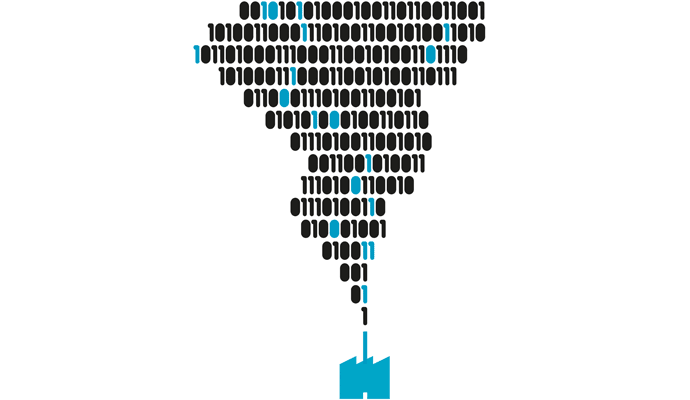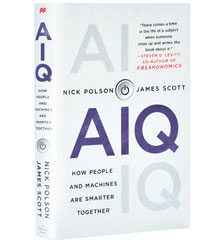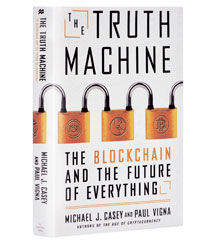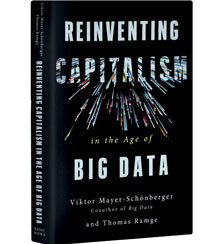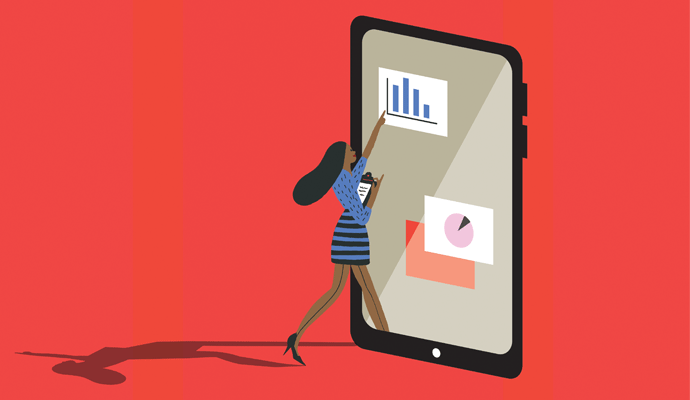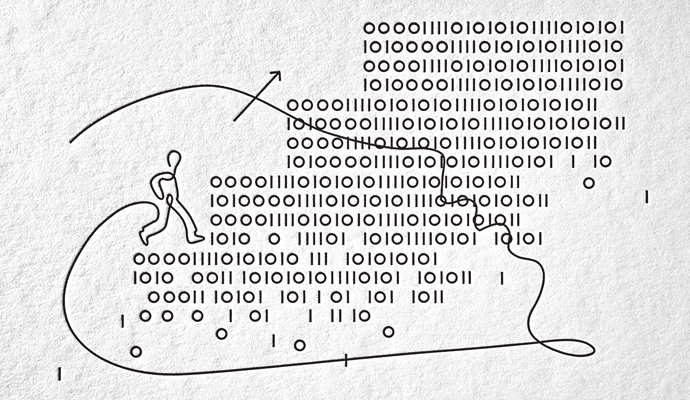Best Business Books 2018: Innovation
Technology Emerging. See also Top Shelf Picks: Best Business Books 2018.
Nick Polson and James Scott
AIQ: How People and Machines Are Smarter Together (St. Martin’s Press, 2018)
Michael J. Casey and Paul Vigna
The Truth Machine: The Blockchain and the Future of Everything (St. Martin’s Press, 2018)
Viktor Mayer-Schönberger and Thomas Ramge
Reinventing Capitalism in the Age of Big Data (Basic Books, 2018)
*A TOP SHELF PICK
Separating substance from hype is perhaps the biggest challenge businesses face when thinking about new technology, because no other field is as riddled with exaggerated promises and utopian fantasies. This year’s best business books on technology and innovation look at three of the hottest drivers of change in today’s economy — AI, blockchain, and big data — and do their best to distinguish what’s real in these technologies from what’s just for show.
Most books on AI fall into one of two categories: prophetic tracts forecasting the arrival of the utopia of self-driving cars and permanent leisure, or, more commonly, dystopian tracts envisioning a future in which robots take all our jobs and people are left to fend for themselves in a world without work. With AIQ: How People and Machines Are Smarter Together, Nick Polson and James Scott take a different, and much-needed, approach, offering up a rigorous yet surprisingly accessible explanation of how AI actually works, coupled with a keen interrogation of its strengths and weaknesses.
Polson and Scott, statisticians who teach at the University of Chicago and the University of Texas, respectively, have gone light on the equations and heavy on the stories. Each chapter illuminates an important artificial intelligence process — conditional probability, pattern recognition, Bayesian updating, anomaly detection, and so on — by telling the story of a historical episode in which that process was especially useful. So they explain conditional probability, the core of things such as Netflix’s recommendation engine, by looking at how mathematician Abraham Wald helped figure out the best way of armoring military bombers. The extraordinary story of a Navy man named John Craven finding a lost submarine in the middle of the Atlantic Ocean explains Bayesian updating, which self-driving cars rely on to get around. And Isaac Newton’s failure as warden of the Royal Mint is used to explain how computers have gotten so good at detecting anomalies, which in turn allow them to identify stolen credit cards, cybersecurity breaches, and insurance fraud.
Rather than a radical break with the past, the authors argue, AI is the latest chapter in the long saga of using science and data to make sense of the world. And although making artificial intelligence work well is a very complex task, the math of AI, as Polson and Scott write, “is surprisingly simple.” As they put it, “When you get right down to it, it’s all just probability on big data steroids.”
Why does this matter to business? It turns out that the mystification of AI — this sense that it’s intelligible only to a select few — has made it harder for companies to think clearly about how to take real advantage of it. To get the most out of AI, organizations need to remake their businesses so that they maximize the collaboration between humans and machines, ensuring that machines amplify humans’ abilities, rather than simply substituting for them. Too few organizations are doing that, which in turn means they’re less productive than they should be.
Demystifying AI can also help dispel some of the fears and anxieties that have sprung up around the subject. Polson and Scott show how algorithms are already helping transform fields as disparate as agriculture and policing. But they’re skeptical that AI is going to make humans redundant, and agnostic about whether so-called human-level intelligence is even on the horizon. And they point to the fact that for all the talk about robots taking our jobs, unemployment has trended steadily downward over the past decade, even as companies’ investments in AI have ramped up. Artificial intelligence certainly threatens individual jobs, but it’s far from clear that it threatens jobs as a whole, at least anytime soon.
As an explainer, AIQ is impeccable, brilliantly making a complicated subject understandable. And while it offers a glowing picture of how AI can get things right, it also clearly lays out how things can go wrong. As Polson and Scott put it, “Algorithms just do exactly what they’re told.” They aren’t capable of understanding when their results don’t fit reality, and they have no ability to recognize when the assumptions that they’re programmed with are profoundly flawed and biased. And algorithms, oddly, also rust — if they aren’t regularly updated and improved, their model of the world becomes less accurate, and they become less effective. These are problems that any business relying on AI needs to be vigilant in managing. Although they’re problems that humans create, they’re also problems that only humans can fix. Polson and Scott write, “It may seem like we depend on smart machines for everything these days. But in reality, they depend on us a lot more.”
Artificially Intelligent Designs
In the last few years, the fascination with AI has been rivaled by interest in blockchain. Blockchain first gained attention because it’s the underlying technology for cryptocurrencies such as bitcoin. But even as speculative interest in cryptocurrencies has flagged, the hype around blockchain has, if anything, grown. In a recent PwC survey of 600 top executives, 84 percent said that their organizations had at least some involvement with blockchain. Companies including JPMorgan Chase and Walmart have made major commitments to it. And blockchain’s most fervent advocates suggest it offers the prospect of revolutionizing not just businesses, but society itself. Yet most people, including most corporate executives, would have a hard time explaining exactly what blockchain is.
The Truth Machine: The Blockchain and the Future of Everything, by Michael J. Casey and Paul Vigna, seeks to remedy that state of affairs. The authors, financial journalists whose previous work was titled The Age of Cryptocurrencies, are true believers in the power of blockchain. But beneath the book’s utopian rhetoric is a subtle, and useful, investigation of what blockchain is, and what we might reasonably expect it to accomplish.
Blockchain is, in essence, a distributed, crypto-graphically secure ledger that can record transactions of all kinds, ranging from currency trades to contracts to the movement of products through a supply chain. Instead of residing on one centralized server, copies of the ledger exist on all computers with access to it. Every transaction is instantly visible, and not reversible. And every transaction needs to be verified and validated by the system as a whole before it can become part of that blockchain. Events that happen on that blockchain are therefore transparent, secure, and indelible — you can’t go back and rewrite history after something has happened. That’s why Casey and Vigna call it a truth machine.
The real promise of blockchain, the authors write, is that in principle it can be applied to a host of substantive problems in the real world. For instance, in countries where property records are byzantine and government is untrustworthy, a blockchain property registry would allow people to easily prove ownership of their homes, cars, and other assets. Peer-to-peer payment systems set up on blockchain would allow people to exchange money without having to go through intermediaries such as credit card companies. Stock trades and interbank payments could be processed in real time, rather than taking two to seven days as they now do.
Casey and Vigna are most interested in the ways in which blockchain could help remake society as a whole. As a result, they spend much of the book looking at what they call “permissionless” blockchain ledgers. These are open ledgers, such as bitcoin, in which (in theory) anyone can participate by connecting a computer and becoming part of the network. Although permissionless systems get most of the attention, blockchain’s biggest impact, at least in the near future, is likely to come via so-called permissioned ledger systems that operate within and between corporations. (Corporate blockchain systems are typically permissioned because of concerns about privacy and competitive advantage.)
Walmart is running a pilot program that uses blockchain to track its food products from the farms of its suppliers to its stores. When the company set up an experimental blockchain for suppliers, in which each step was recorded on a distributed ledger (and therefore instantly updated on every computer on the network), the company was suddenly able to get a full picture of the path of a single piece of fruit in a matter of seconds. A system like that would be highly valuable during an outbreak of a foodborne illness. But you could imagine similar applications with consumer products that would allow companies to attest to the origins and safety of their products and the conditions under which they’re made. Blockchain technology could also transform internal financial reporting, making it more difficult for people to game the system, and making it easier to do up-to-the-minute financial reporting.
Of course, just because blockchain could significantly boost transparency and efficiency inside companies doesn’t mean it will. As Casey and Vigna make clear, the decentralized and distributed nature of blockchain has real costs — it takes a lot of energy and resources to maintain and protect these highly redundant systems. And although the PwC survey showed that the vast majority of corporations are interested in blockchain technology, we have yet to see widespread, large-scale applications developed. Even more than AI, blockchain is something most executives know they should care about, but haven’t yet really figured out how to use. Casey and Vigna’s book would be a good place to start.
Data Mines
Both AI and blockchain are ultimately about data — how to record it, manage it, manipulate it, and learn from it. Data has become central to the way most corporations work, even when they aren’t obviously in the data business. The ascendance of data represents a radical shift in the nature of business, argue Viktor Mayer-Schönberger and Thomas Ramge in Reinventing Capitalism in the Age of Big Data, the best business book of the year on technology and innovation. What we are witnessing, they contend, is the advent of an economy in which data matters far more than capital, a change that represents “a fundamental reorganization of our economy.”
What does that mean in practice? The key insight of Mayer-Schönberger, the Oll Professor of Internet Governance and Regulation at Oxford University, and Ramge, a German technology journalist, is that up to this point, we’ve used price as the key determinant of how resources are allocated — what we make, how much of it we make, what we invest in, and so on. We’ve done this because prices convey information about supply and demand — how much people want to buy and sell things — in a condensed, easy-to-understand form. But for all its effectiveness, price is also a blunt instrument. It can’t fully convey the intensity of people’s preferences. It can’t let businesses know what consumers might want instead of what they’re selling, or even how much they’d be willing to pay for the things they do buy.
The advent of big data — by which Mayer-Schönberger and Ramge mean the combination of massive databases and algorithmic analysis — changes all this. Now, it’s much easier to get a clearer, if still imperfect, picture of what people actually want. It’s possible to understand individual demand, and to customize responses to meet that demand. And you can do this, in many cases, without ever asking individuals directly what they want. Instead, you can simply follow the traces they leave as they move through the digital world — the things they click on and the things they don’t, the amount of time they spend on one site rather than another.
Businesses can now get a much closer look at potential suppliers and partners, as well as at their own internal operations. (Think of how much simpler it is for corporations to track the work of their employees than it once was.) It’s easier than ever to enter into, and successfully monitor, partnerships, and to outsource even core corporate functions to outside players. Intermediaries and brokers are less important. As a result, the transaction costs of doing business outside corporate walls are falling, which means that the economic case for the traditional big corporation (which exists in large part because of its ability to coordinate production with a minimum of transaction costs) is getting weaker. For Mayer-Schönberger and Ramge, this means that markets are becoming more important than firms, and the traditional corporation is at risk of becoming obsolete.
The transaction costs of doing business outside corporate walls are falling, which means that the economic case for the traditional big corporation is getting weaker.
That seems like an absurd conclusion, especially at a historic moment when big corporations are more profitable than ever, and when more and more industries are dominated by a small number of players. But Reinventing Capitalism in the Age of Big Data suggests that the future instead might be one of smaller, niche firms making customized products, coordinating production with one another through the market, and doing so as efficiently as big firms are able to. If there are hundreds or even thousands of companies that can, say, make an auto part or a computer chip, and you can vet those companies with ease and make a deal with any one of them with the click of a button, it’s not obvious that it makes economic sense to do the work in-house or to rely on just one or two main suppliers. Similarly, economies of scale matter less in a world where mass customization — discovering exactly what a consumer wants and delivering it to him or her — is possible.
If the advent of big data clears the way for small companies to shine, though, some very big players will continue to enjoy advantages: the companies that are the gatekeepers to all that data. There’s a positive feedback loop at work in the data economy. The more data you have, the more AI can learn to make your algorithms better. The better your algorithms are, the more likely it is that you’ll deliver what consumers are actually looking for. The data-rich companies such as Google, Amazon, and Facebook will get richer.
This is the great paradox of Mayer-Schönberger and Ramge’s vision of the future. On the one hand, they argue that “data capitalism” empowers consumers, erodes the power of the traditional corporation, and elevates the market above the firm. On the other hand, data capitalism gives a few big corporations extraordinary power. The authors recognize this, and argue for what they call a data-sharing mandate, whereby companies are required to share their data troves with competitors. That would help weaken these companies’ competitive strength; however, it seems unlikely to become law. But in lieu of such a law, or concerted antitrust action against these companies, the future of the data economy will likely look very much like the present of the data economy. Meet the new boss, same as the old boss.


